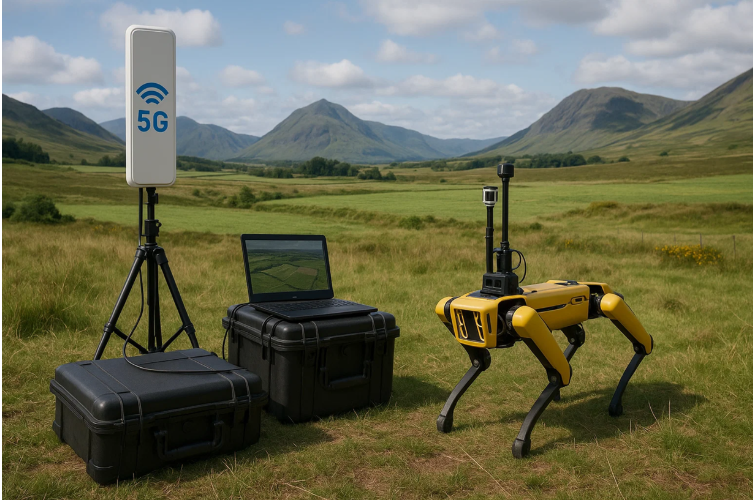Recent field trials in Scotland demonstrate how portable 5G private networks support tether-free robotic units—like Boston Dynamics’ Spot robot dog—to gather high-resolution agronomic data live in remote areas. This report outlines the system design, hardware and software setup, communication protocols, field-use cases, and performance outcomes. So, now let us look into Portable 5G for Robotic Field Operations in Scotland along with RantCell’s LTE RF drive test tools in telecom & RF drive test software in telecom and RantCell’s Mobile Network Monitoring Tools, Mobile Network Drive Test Tools, Mobile Network Testing Tools in detail.
- System Overview
- Robotic Unit: Spot, the quadruped robot from Boston Dynamics, equipped with LiDAR, stereo cameras, and thermal/infrared sensors for mapping and crop assessment
- 5G Network Setup: Rapid-deployment private 5G network, powered by Freshwave using n77 spectrum under Ofcom licence. The network includes a self-contained pop-up mast and generator, enabling quick setup in inaccessible farm zones
- Data Interface: Control station with VR headset and HMI (human–machine interface) connects to Spot via a low-latency 5G uplink for command and video streaming.
- Cloud & Edge Integration: Real-time edge computing processes incoming sensor streams and 3D visual models on high-capacity servers. Cloud components handle asynchronous analytics like multispectral mapping and disease detection models.
- Connectivity Architecture
2.1 Private 5G Network
- Spectrum Allocation: Uses n77 band licensed by Ofcom.
- Network Design: Standalone private network (SA), built to support <10 ms end-to-end latency and up to several hundred Mbps per device.
- Deployment: Field sites receive full coverage within minutes after installing mobile mast and power supply.
2.2 Protocol Stack
- Control Loop: Commands from the pilot are sent via UDP for actuator control; camera and LiDAR data are transmitted reliably over TCP.
- API Layer: ROS2 message buses (TCPROS or ROS2 DDS) forward telemetry and command payloads over 5G.
- Edge Services: Deployed close to the mast, processing path planning, image segmentation, and SLAM. Selected tasks—like object detection—are handled via HTTP/gRPC calls to centralized cloud servers.
- Robotic Field Tasks
3.1 Live Crop Health Mapping
- Sensors: RGB cameras, LiDAR, and infrared to generate 3D + thermal crop maps.
- Processing: Edge algorithms generate real-time point-cloud maps and temperature anomaly detection. Summarized field metrics are uploaded to cloud-based dashboards.
- Use Case: Operators scan 2 hectares in ~15 minutes, detect early heat/water stress zones, and mark areas for intervention based on thermal thresholds.
3.2 Soil Condition Scanning
- Methods: Infrared and LiDAR used to assess terrain texture and moisture. RGB images feed into cloud services for NDVI and soil compaction estimation.
- Performance: A 5G uplink allows a compressed map (~50 MB) to upload in seconds, enabling near real-time analytics.
3.3 Targeted Application Trials
- Potential Configurations: By adding payloads (e.g., pesticide sprayer or granular spreader), the setup supports localized application.
- Networking Role: Real-time 3D models allow pinpoint accuracy of sprayer deployment within ±5 cm. Edge/cloud axis handles volume control and operational safety.
3.4 Swarm Robotics Potential
- Architecture: Multiple Spot units can form a mesh, syncing perception and path data via 5G broadcast.
- Next Steps: Planning to trial synchronized weed removal and soil sampling in a robotics fleet environment.
- Field Performance & Metrics
4.1 Latency and Data Rates
- Achieved Latency: <10 ms round-trip, enabling low-lag remote control.
- Throughput: Peak aggregated rate ~200 Mbps, sufficient for 4K video (~25 Mbps each) and LiDAR (~50 Mbps), streamed concurrently.
4.2 Power and Mobility
- The pop-up mast runs on integrated generator/battery modules. Setup-to-operations time is under 2 hours.
- Robust network performance even when mast-to-robot distance reaches 500 m over rough terrain.
4.3 Cost-Benefit Metrics
- Portable network setup costs are a fraction of fiber or satellite backhaul.
- Field trials show labor cost reductions of ~30% and yields improvement of ~5% via early stress detection—all without permanent infrastructure investment.
- Comparative Analysis: 4G, Wi-Fi 6 vs 5G
| Technology | Latency | Throughput | Viability for Robotics |
| 4G | ~50–100 ms | ~20–50 Mbps | Insufficient for real-time control |
| Wi-Fi 6 | ~2–10 ms (short range) | ~100–200 Mbps | High throughput but limited range |
| 5G-SA | <10 ms | ~100–300 Mbps | Combines low latency and field-wide coverage |
5G provides a balanced solution: Wide coverage, consistent throughput, and low latency—without the range limits of Wi-Fi 6.
- Next Phases
6.1 Automatic Crop Diagnosis
Ongoing development includes onboard AI for disease/pest/water-stress recognition. Cloud training is fed by thermal and RGB edge inputs. Production-ready detection is expected within 12 months.
6.2 Robotics Swarms
Prototypes are in creation for coordinating multi-robot tasks: e.g., Spot duo executing simultaneous weeding and yield estimation, all through synchronized 5G communication.
6.3 Integration with UAVs
Adding drones increases situational awareness. UAVs capture aerial multispectral imagery, process initial indicators, and cue Spot for ground-level scans via 5G.
- Broader Implications
7.1 Adapting Infrastructure
Private 5G can be mobilized seasonally. Sites sharing infrastructure (orchards, grazing land) benefit from flexible coverage that fibers cannot match.
7.2 Skillset Evolution
Farm teams will need to manage robotic control, sensor calibration, and network diagnostics. Robotics-as-a-service models may emerge to supply skilled operators.
7.3 Economic and Environmental Impact
- Economics: Labour savings and production gains reduce cost-per-unit for crops.
- Environmental: Precision input delivery reduces agrochemical usage and runoff, lowering ecological footprint.
Conclusion
The Scottish field trials validate that a portable 5G private network enabling high-bandwidth, low-latency links supports sophisticated robotic systems in remote agriculture. Real-time mapping, crop health analytics, and precision actuation become feasible outside labs. Early field deployments report 10–30% efficiency gains and prove cost-effective compared to fixed infrastructure. With active development in AI-based diagnostics, multiple robot coordination, and UAV integration, next-year trials aim to expand use into commercial farms. This system design establishes a foundation for data-centric agri-robotics and could transform rural agriculture.
About RantCell
RantCell allows users to test and monitor mobile network quality across 2G to 5G using Android smartphones—without needing traditional RF test equipment. Whether you are an MNO, enterprise IT team, or system integrator, RantCell enables easy remote testing, data collection, and performance reporting. The solution supports features like active testing, Layer 3 logging, crowdsourcing, and drive test automation, making it ideal for cost-effective network audits and optimization projects. Also read similar articles from here.





